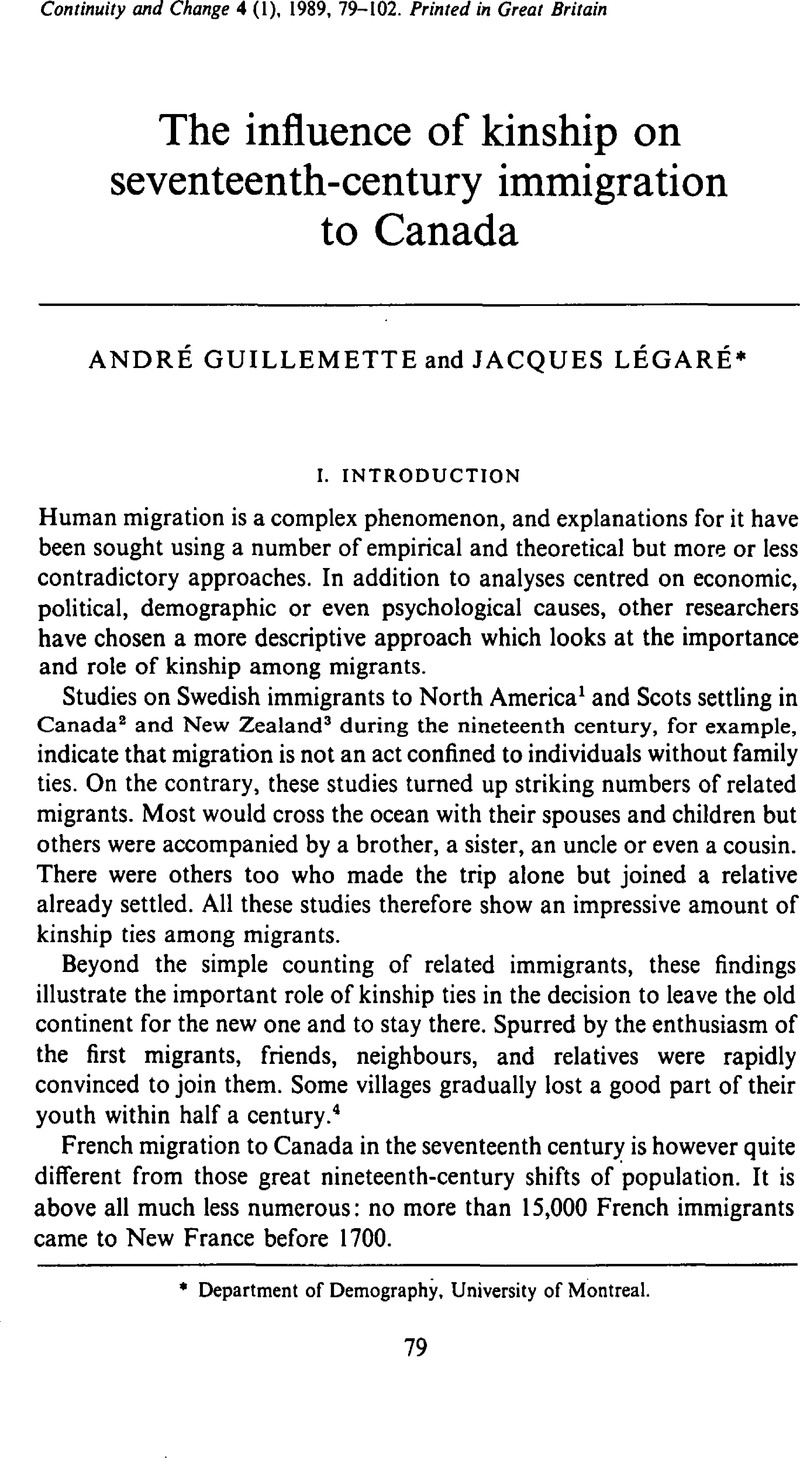Article contents
The influence of kinship on seventeenth-century immigration to Canada
Published online by Cambridge University Press: 29 January 2009
Abstract

- Type
- Articles
- Information
- Copyright
- Copyright © Cambridge University Press 1989
References
ENDNOTES
1 Ostergen, Robert C., ‘A community transplanted: the formative experience of a Swedish immigrant community in the Upper Middle-West’, Journal of Historical Geography 5 (1979) 189–212CrossRefGoogle Scholar and from the same author, ‘Kinship networks and migration: a nineteenth-century Swedish example’. Social Science History 6 (1982) 293–320.Google Scholar
2 Omner, Rosemary E., ‘Highland Scot migration to southwestern New Foundland: a study of kinship’, in Mannion, J., ed., The peopling of New Foundland (St-John, 1977) 212–33.Google Scholar
3 Molloy, Maureen, ‘No inclination to mix with strangers: marriage patterns among Highland Scots migrants to Cape Breton and New Zealand, 1800–1916’, Journal of Family History 11 (1986) 221–43.CrossRefGoogle Scholar
4 Ostergen, , ‘Kinship networks and migration’, 302–3.Google Scholar
5 Harris, Cole, ‘The French background of immigrants to Canada before 1700’, Cahiers de geographie de Québec 16 (1972) 313–24CrossRefGoogle Scholar; Beauregard, Y., Goudreau, S., Héroux, A., Jean, M., Lessard, R., Noel, J., Paquet, L. and Laberge, A., ‘Famille, parenté et colonisation en Nouvelle-France’, Revue d'histoire de l'Amérique française 39 (1986) 391–405CrossRefGoogle Scholar; Mathieu, J., Therrien-Fortier, P., Lessard, R., ‘Mobilité et sédentarité: stratégie familiale en Nouvelle-France’, Recherches Sociographiques 28 (1987) 211–27.CrossRefGoogle Scholar
6 The territory of seventeenth-century Canada corresponded basically to that of the present-day province of Quebec.
7 See for example, Beider, Robert E., ‘Kinship as a factor in migration’, Journal of Marriage and Family 35 (1973) 429–39CrossRefGoogle Scholar; Molloy, , ‘No inclination to mix with strangers’, 221–43.Google Scholar
8 Jetté, René, Dictionnaire généalogique des families du Québec, des origines a 1730 (Montréal, 1983).Google Scholar
9 Trudel, Marcel, Catalogue des immigrants, 1632–1662 (Montréal, 1983).Google Scholar
10 For a detailed description of the P.R.D.H. and the population register, see Légaré, J., ‘A population register for Canada under the French Regime: context, scope, content and applications’, Canadian Studies in Population 15 (1988).CrossRefGoogle Scholar The P.R.D.H. is funded by grants from the Social Sciences and Humanities Research Council of Canada, the Quebec F.C.A.R. fund and the University of Montreal.
11 These biological and marital ties include the relations between spouses, parents and children, brothers and sisters, cousins, an uncle and a nephew, son-in-law and mother-in-law, grandfather and grandson, etc.
12 Moogk, Peter N., ‘“Triste endroit”: the failure of private emigration to French North America, 1640–1760’Google Scholar, paper read at the annual meeting of the Canadian Historical Association, Guelph, June 1984.
13 Dickinson, John A., ‘Les Amérindiens et les débuts de la Nouvelle-France’, in Canada ieri e oggiGoogle Scholar, atti del 6e Convegno internazionale di studi canadesi, Selva di Fasano, March 27–31, 1985, 93–5.
14 Charbonneau, Hubert and Landry, Yves, ‘La politique démographique en Nouvelle-France’, Annales de démographie historique (1979) 29–57.Google Scholar
15 Charbonneau, and Landry, , ‘La politique démographique en Nouvelle-France’, 36–7.Google Scholar
16 Charbonneau, H., Desjardins, B., Guillemette, A., Landry, Y., Légaré, J. and Nault, F., Naissance d'une population: les Français établis au Canada au XVIIe siècle (Paris/Montréal, 1987) 15.Google Scholar
17 Gemery, Henry A., ‘Emigration from the British Isles to the New World, 1630–1700: inferences from colonial populations’, Research in Economic History 5 (1980) 215.Google Scholar
18 The various regions have been classified as follows. To the north of the Loire were those of Brittany, Normandy (including Perche), Paris (including He de France, Brie and Beauce), Loire (including Anjou, Maine, Orléanais and Touraine), North (including Artois, Flanders and Picardy), and East (including Alsace, Burgundy, Champagne, Franche-Comté, Lorraine and Lyonnais). T the south of the Loire were those of West (including Angoumois, Aunis, Poitou and Saintonge), Centre (including Auvergne, Berry, Bourbonnais, Limousin, Marche and Nivernois), and South (including Béarn, Comte de Foix, Dauphine, Gascony, Guyenne, Languedoc, Périgord, Provence, Roussillon and Savoy).
19 Renaud, Paul-Emile, Les origines économiques du Canada: l'oeuvre de la France (Namers, 1928) 236.Google Scholar
20 Dumas, S., Les filles du roi en Nouvelle-France. Etude historique avec répertoire biographique (Québec, 1972) 33–4.Google Scholar
21 For practical reasons, this group will henceforth be designated as ‘unmarried adults’.
22 Those French immigrants whose region of origin is unknown are obviously not included in this calculation.
23 Trudel, Marcel, Histoire de la Nouvelle-France 3Google Scholar; La seigneurie des Cent-Associes, Book 2: La société (Montréal, 1983) 24.Google Scholar
24 Laslett, Peter, ‘Introduction: the history of the family’, in Laslett, Peter and Wall, Richard, eds., Household and family in the past time (Cambridge, 1973) 1–89.Google Scholar Despite the use of Laslett's terminology, family networks are not households, since they are not residence groups but groups of kins migrating together or in successive waves.
25 As observation closed in 1699, it is not unreasonable to suppose that this time-lapse might be even greater as more relatives arrived in subsequent years.
26 Ostergen, ‘A community transplanted’, 193.
27 Robert E. Beider, ‘Kinship as a factor in migration’, 435.
28 Beauregard et al., ‘Famille, parenté et colonisation en Nouvelle-France’, 402.
- 5
- Cited by




